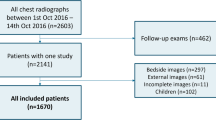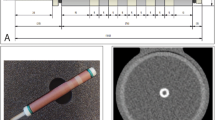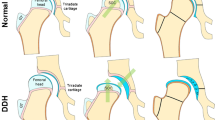Abstract
The size of the esophageal hiatus is clinically important for preserving the integrity of the lower esophageal sphincter mechanism. The purpose of this study was to systematically establish the mean hiatal surface area (HSA) for normal North American adults under physiologic conditions and assess the relationship between sex and age on HSA. Multi-Detector Computer Tomogram (MDCT) images of the esophageal hiatus in 119 healthy adult subjects (61 males and 58 females with an age range of 24–88 years) were retrospectively analyzed using the multi-planar reconstruction (MPR) technique to directly measure their hiatal length (long axis), width (short axis) and surface area at end inspiration. The mean HSA for males was 2.88 cm2, with a standard deviation of 0.74 cm2. The mean HSA for females was 2.51 cm2, with a standard deviation of 0.68 cm2. There was a statistically significant difference in HSA between males and females (p = 0.0053); however, there was no statistically significant difference between the HSA among different age groups (p = 0.8439). Similarly, significant differences between males and females were demonstrated in both the length (p = 0.0263) and width (p = 0.0311) measurements, but there was no evidence of an association of these parameters with age. For the first time, the normal size of the hiatus at end inspiration has been established noninvasively for a population of healthy adults from MDCT images.





Similar content being viewed by others
References
Batirel HF, Uygur-Bayramicli O, Giral A, Ekici B, Bekiroglu N, Yildizeli B, Yuksel M (2010) The size of the esophageal hiatus in gastroesophageal reflux pathophysiology: outcome of intraoperative measurements. J Gastrointest Surg 14:38–44. https://doi.org/10.1007/s11605-009-1047-8
Boos J, Lanzman RS, Meineke A, Heusch P, Sawicki LM, AntochG KP (2015) Dose monitoring using the DICOM structured report: assessment of the relationship between cumulative radiation exposure and BMI in abdominal CT. Clin Radiol 70:176–182. https://doi.org/10.1016/j.crad.2014.11.002
Boru CE, Rengo M, Iossa A, De Angelis F, Massaro M, Spagnoli A, Guida A, Laghi A, Silecchia G (2021) Hiatal surface area’s CT scan measurement is useful in hiatal hernia’s treatment of bariatric patients. Minim Invasive Ther Allied Technol 30(2):86–93. https://doi.org/10.1080/13645706.2019.1683033
Granderath FA, Schweiger UM, Pointner R (2007) Laparoscopic antireflux surgery: Tailoring the hiatal closure to the size of the hiatal surface area. Surg Endosc 21(4):542–548. https://doi.org/10.1007/s00464-006-9041-7
Herwaarden MA, Samsom M, Smout AJ (2004) The role of hiatus hernia in gastro-oesophageal reflux disease. Eur J Gastroenterol Hepatol 16(9):831–835. https://doi.org/10.1097/00042737-200409000-00003
Katzka DA, Kahrilas PJ (2020) Advances in the diagnosis and management of gastroesophageal reflux disease. BMJ 23:371–378. https://doi.org/10.1136/bmj.m3786
Koch OO, Kaindlstorfer A, Antoniou SA, Asche KU, Granderath FA, Pointner R (2012) Influence of the esophageal hiatus size on the lower esophageal sphincter, on reflux activity and on symptomatology. Dis Esophagus 25(3):201–208. https://doi.org/10.1111/j.1442-2050.2011.01238
Loukas M, Wartmann ChT, Tubbs RS, Apaydin N, Louis RG Jr, Gupta AA, Jordan R (2008) Morphologic variation of the diaphragmatic crura: a correlation with pathologic processes of the esophageal hiatus? Folia Morphol (Warsz) 67(4):273–279
Mittal RK, Balaban DH (1997) The esophagogastric junction. N Engl J Med 336:924–932. https://doi.org/10.1056/NEJM199703273361306
Mittal RK, Goyal RK (2006) Sphincter mechanisms at the lower end of the esophagus. GI Motil. https://doi.org/10.1038/gimo14
Moten AS, Ouyang W, Hava S, Zhao H, Caroline D, Abbas A, Dass C (2020) In vivo measurement of esophageal hiatus surface area using MDCT: description of the methodology and clinical validation. Abdom Radiol (NY) 45:2656–2662. https://doi.org/10.1007/s00261-019-02279-7
Orlando RC (2003) Pathogenesis of gastroesophageal reflux disease. Am J Med Sci 42(5):584–588
Ouyang W, Dass C, Zhao H, Kim C, Criner G, COPD Gene Investigators (2016) Multiplanar MDCT measurement of esophageal hiatus surface area: Association with hiatal hernia and GERD. Surg Endosc 30(6):2465–2472. https://doi.org/10.1007/s00464-015-4499-9
Rengo M, Boru CE, Badia S, Iossa A, Bellini D, Picchia S, Panvini N, Carbone I, Silecchia G, Laghi A (2021) Preoperative measurement of the hiatal surface with MDCT: impact on surgical planning. Radiol Med 126(12):1508–1517. https://doi.org/10.1007/s11547-021-01413-0
Shaheen N, Ransohof DF (2002) Gastroesophageal reflux, barrett esophagus, and esophageal cancer: scientific review. JAMA 287(15):1972–1981. https://doi.org/10.1001/jama.287.15.1972
Shamiyeh A, Szabo K, Granderath FA, Syre G, Wayand W, Zehetner J (2010) The esophageal hiatus: what is the normal size? Surg Endosc 24(5):988–991. https://doi.org/10.1007/s00464-009-0711-0
Author information
Authors and Affiliations
Corresponding author
Ethics declarations
Conflict of interest
The authors have no relevant financial or non-financial interests to disclose, no competing interests to declare that are relevant to the content of this article, no affiliations with or involvement in any organization or entity with any financial interest or non-financial interest in the subject matter or materials discussed in this manuscript and no financial or proprietary interests in any material discussed in this article.
Additional information
Publisher's Note
Springer Nature remains neutral with regard to jurisdictional claims in published maps and institutional affiliations.
Rights and permissions
About this article
Cite this article
Dass, C., Dass, G., Fisher, S. et al. The effect of age and sex on esophageal hiatal surface area among normal North American adults using multidetector computed tomography. Surg Radiol Anat 44, 899–906 (2022). https://doi.org/10.1007/s00276-022-02957-0
Received:
Accepted:
Published:
Issue Date:
DOI: https://doi.org/10.1007/s00276-022-02957-0




